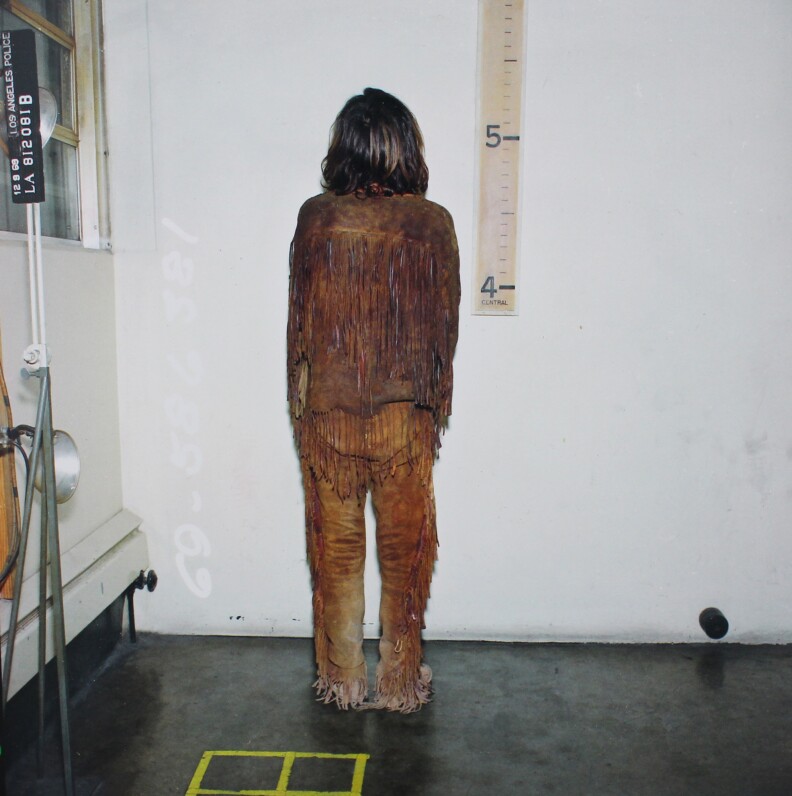WARNING: Some of these images are graphic in nature.
Photography fans might want to visit Paramount Studios' New York City backlot this weekend for Paris Photo, a huge art show featuring 80 photo and video artists from around the world. It was started in 1996 and is usually held at the Grand Palais in Paris, France. This is the second year that the event has been held in Los Angeles.
One of the most striking exhibits at the event is a collection of rare crime scene photos unearthed from the LAPD's archives, dating as far back as 1925 up to the 1960s. These photos never would have seen the light of day if it weren't for photographer/LAPD reserve officer Merrick Morton and his wife Robin Blackman.
Under the gallery name, Fototeka, the couple has spent years culling the LAPD's records to bring these images to light. But gaining access to the photos wasn't easy.
The images were shot for evidence and contained confidential and sensitive content that the LAPD was hesitant to open up to the public.
"I remember the quote from the city archivist at the time, she said she likes my idea, but hell will freeze over before they give you any access to this," said Merrick.
But that all changed when Merrick met John Thomas, adjutant to then-Police Chief Bernard Parks, who had been working on an archival project about African-American LAPD officers. Together, they wrote a proposal to Chief Parks who granted them access.
"To our surprise he said, 'OK, you can have access to these.' So we were actually the first people ever allowed access to actually sift through these negatives," said Morton. "We're talking hundreds of thousands."
Take Two caught up with Merrick Morton and Robin Blackman at the Paramount Lot for a preview of the show, and to find out more about these fascinating historical images.
Interview Highlights:
On first beginning this massive project:
Robin Blackman: "I was a little overwhelmed, because I'm the one who organizes everything. He's the hunter and I'm the organizer, so I knew it was going to be a huge task. We were dealing with old negatives and old envelopes and deterioration and chemical issues as well. It was huge and it was huge that we saved it...They would have been sitting on the shelves in the shortage facility where it was not temperature controlled. It's an environment meant for paper and not for negatives. We had no idea we were going to walk into that when it happened."
On the image of the Black Dahlia murder scene:
Robin: "We're from here, born and raised in L.A., and we love seeing not only what the crime is, but what's going on behind it. The documentation of what the city was 50 or 70 years ago.
Merrick: "And also, when we choose an image, let's say from this case here, we're trying to choose something that's not exploiting it. The image is graphic in its nature but I think when it's included when the architecture, with the hills and the landscape, I think it turns into a piece of art more than just this crime scene of her."
On the art behind these crime scene photos:
Robin: "The photographers are amazing. They are trained photographers, and they have an extra eye...is what we've discovered. For instance, he framed [Image #2 in the slideshow] so perfectly, he knew what he was doing. You see repeats of the way room interiors and exteriors are shot, but because they are photographers and they have that eye, I suppose they couldn't help themselves but capture something like this.
Merrick: For us this is the iconic LA image of film noir. We actually had a friend who we were speaking to about this image and he said, for him to purchase this image and have it hanging on his wall, it's like hanging a Raymond Chandler image on his wall."
On how the LA film industry was inspired by these photos:
Merrick: "Sometimes filmmakers would have access to seeing these images. We have a shot of Alfred Hitchcock from the early 1950s and he's looking through some of the crime books and some of the images. So when he goes out and shoots a film, is he saying, 'I saw this great image, let's set the scene like this'?
On the images of Charles Manson's first police photos after the Tate-LaBianca murders:
Merrick: The thing that stands out is when you look at the height/scale there, he was only 5-foot-3 inches tall. He's always seen and he's projected as this larger-than-life person, but in reality he's a very small person."
On the future of this project:
Robin: "We would love to see this as a public database that people can access and use as reference material, similar to what the New York Municipal archives offers. So we hope to have that one day and have every image archived and documented and all the metadata collected and everything in one place and the negatives are safe in another place. Would really love to see that happen."
Paris Photo is open to the public starting Friday, April 25 until Sunday, April 27. Fototeka is under contract with the LA Cultural Affairs Department and the LAPD to create an online archive of the photos, which will eventually be accessible to the public.













